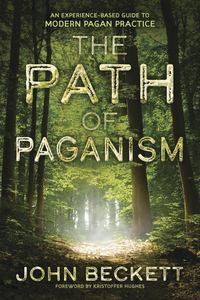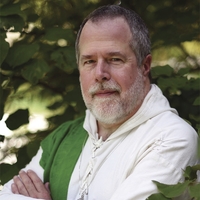 The Path of Paganism: An Experience-Based Guide to Modern Pagan Practice by John Beckett. Published by Llewellyn Publications (336 pages).
The Path of Paganism: An Experience-Based Guide to Modern Pagan Practice by John Beckett. Published by Llewellyn Publications (336 pages).
Walking a Pagan path will always have its challenges and whatever stage of the path we are on, a guide who give us pause for reflection on key aspects of our beliefs and practices is most welcome. This is why John Beckett’s new book The Path of Paganism, to be released in May, is so important.
Beckett is a Druid who was raised in what he describes as a fundamentalist Christian family, finding his way to Paganism when he was an adult. Beckett is a member of the Order of Bards, Ovates and Druids (OBOD) and an officer of the Covenant of Unitarian Universalist Pagans (CUUPS).
With a foreword by the renowned Kristoffer Hughes, head of the Anglesey Druid Order, Beckett’s book is made up of four parts: Building a Foundation, Putting it Into Practice, Intermediate Practice, Living at the Edge. These areas flow effortlessly together to cover the three main junctures of the Pagan path, the initiate, the experienced and the leader or mentor.
The book is written from an unashamedly experiential perspective, which I fully applaud, and it includes some solid rituals not only for newer Pagans to practice, but for the more experienced to try as well. It is punctuated with opportunities for reflection upon your path and practice, which are very thought-provoking and stimulating.
The book begins with a discussion of religion and faith, and how Paganism fits into to these belief systems. It’s a thorough look that serves to dispel some misgivings for newer Pagans, as well as being thought-provoking for more experienced ones. I particularly enjoyed the discussion about mystical experiences and how they operate in a Pagan context.
I have often found that many Pagans are reticent to talk about their spiritual and mystical experiences, and there are good reasons for this. However, Beckett is very open about such work without disclosing any private detail. I found this acknowledgement very healthy and refreshing.
Beckett is also very down-to-Earth and grounded in describing such encounters. He states: “Mystical experiences come on their own timetables, but they come far more regularly when you work at them.”
I also agreed with him when he argued in Chapter 4 that lore and experience should be valued in roughly equal measure.
That section of the book also explores what Paganism is and how it operates. Beckett’s metaphor of a big tent held up by the four pillars of self, nature, community, and gods seems to be right on the money as far as I’m concerned. No matter what Pagan path we walk, these four aspects show up time and again, so his metaphor works well, as does his idea that each Pagan will usually gravitate toward one or two of the pillars.
In those terms, Beckett describes himself as a nature ‘n’ gods type of guy and “that is where you will find me in the tent”.
Later on, he describes how all of these pillars are necessary to uphold Paganism and that embracing this variety should be encouraged as it gives the movement depth and interest. The burgeoning scholarly tradition in Paganism can be far removed from Pagan activism, for example, but both are important ways of being recognised in the mainstream world.
The second section is a solid primer for anyone just getting started on the Pagan path. It covers how to establish a daily practice, as well as offering some good, straightforward rituals on how to call the four directions, a devotion to Cernunnos, how to honour the ancestors and information on setting up an altar.
These may be details that a more experienced Pagan takes for granted, but they can be daunting for newer Pagans. As it is written from an experiential perspective, Beckett feels like a very capable pair of hands to lead you through the process. This section is also useful as a gentle reminder for more experienced practitioners, including a discussion on the importance of ritual and daily practice and refreshing one’s altar.
Beckett uses himself as an example on this in a story about his own sacred space in Chapter 8.
He also included an interesting discussion in this section about living as a Pagan in a materialistic, exploitative world and the risk of becoming too hung up on idealistic perfection, especially when it comes to consumer choice. I like the fact that Beckett acknowledges that it is very difficult, especially if you are on a lower income, to make ethical purchases 100% of the time. This epitomises his approach to Druidry: practical, humble, and wise.
As Beckett says: “Do your best to align your life with your values. Make compromises you can live with—compromises some will find too large and others will find too small. Understand that other informed, mindful Pagans will make compromises that look very different from yours. Have some humility and some compassion, because neither you nor they are ethically pure.”

As we enter the third part of the book, it shifts up a gear and begins to speak to the more experienced Pagans. This is important. Many Pagan texts, in my experience, do not address the everyday challenges that can occur further along the path, like being in a spiritual plateau, re-invigorating your practice, widening your circle and considering new roles.Reading this part of the book, in particular, was a real breath of fresh air.
In this section, Beckett also picks up his earlier thread on the importance of community. Having previously discussed how to go about picking a suitable one, Beckett gently invites the reader to contemplate the importance of such a community and to reflect on how your operations in the wider world can serve to embed your Pagan beliefs.
I particularly enjoyed his use of the liminal zones metaphor in Chapter 13 to describe such plateaus and other times when our practice is changing. I found this to be a very uplifting way of dealing with periods when difficult change is upon us. As Beckett says: “There is no point of change, only a zone of change.” I think this is particularly helpful for when your practice feels stagnant.
As the section continues and in true liminal fashion begins to edge toward the leader or mentorship part of the path, Beckett discusses his model of group dynamics. This uses a series of concentric circles and operates on a horizontal level rather than vertical hierarchy. It’s good to see direct democracy-type structures being integrated into Pagan thought.
In his model, the core principles and values are at the centre, with the mission and vision being the second circle. The third circle is the core leaders, followed by committed members and then fanning out to casual members and occasional visitors in the remaining circles respectively, with seekers being outside the circles. It’s a very interesting model, which will hopefully be continued in future Pagan texts.
The section ends with a conversation about how to create rituals and the importance of private and public practice. It also explores how to initiate others and begins to move into the realm of Pagan priesthood.
The final section of the book discusses the cyclical nature of the path and how often we move, as if on a spiral through the forest. The implication is that once we reach the seeming pinnacle of leadership or mentorship, there is inevitably more to learn and new, exciting vistas await us as we, in Beckett’s words, “find our place in the circle”.
A great deal of the book focuses on the experience of being Pagan and the challenges and plateaus we are likely to experience along the way through the forest. His approach is refreshing in that it acknowledges, as with any rhythmic behaviour, that a certain jadedness can creep in. Pagan practice is no exception. This is especially pertinent in the latter two sections of the book where Beckett gently invites those further along the path to consider new ways of practising and contemplating what they do.
The Path of Paganism is a solid guide and knowledgeable companion for anyone on the Pagan path. It has a comprehensive introduction for beginners and discusses at length the various challenges and issues that can arise for people who are starting out. It also has a philosophical discussion on Paganism, religion, and faith that is a good exploration of what to expect, and will become food for thought for those further along the path. The book is also engages concepts for experienced Pagans who seek to keep their practice fresh, relevant, and ever-growing.
The book, published by Lewellyn, will be released May 8. It is available for pre-order at Amazon. John Beckett’s writing can also be found on his blog at the Patheos Pagan Channel.
Enjoy the journey.
The Wild Hunt is not responsible for links to external content.
To join a conversation on this post:
Visit our The Wild Hunt subreddit! Point your favorite browser to https://www.reddit.com/r/The_Wild_Hunt_News/, then click “JOIN”. Make sure to click the bell, too, to be notified of new articles posted to our subreddit.